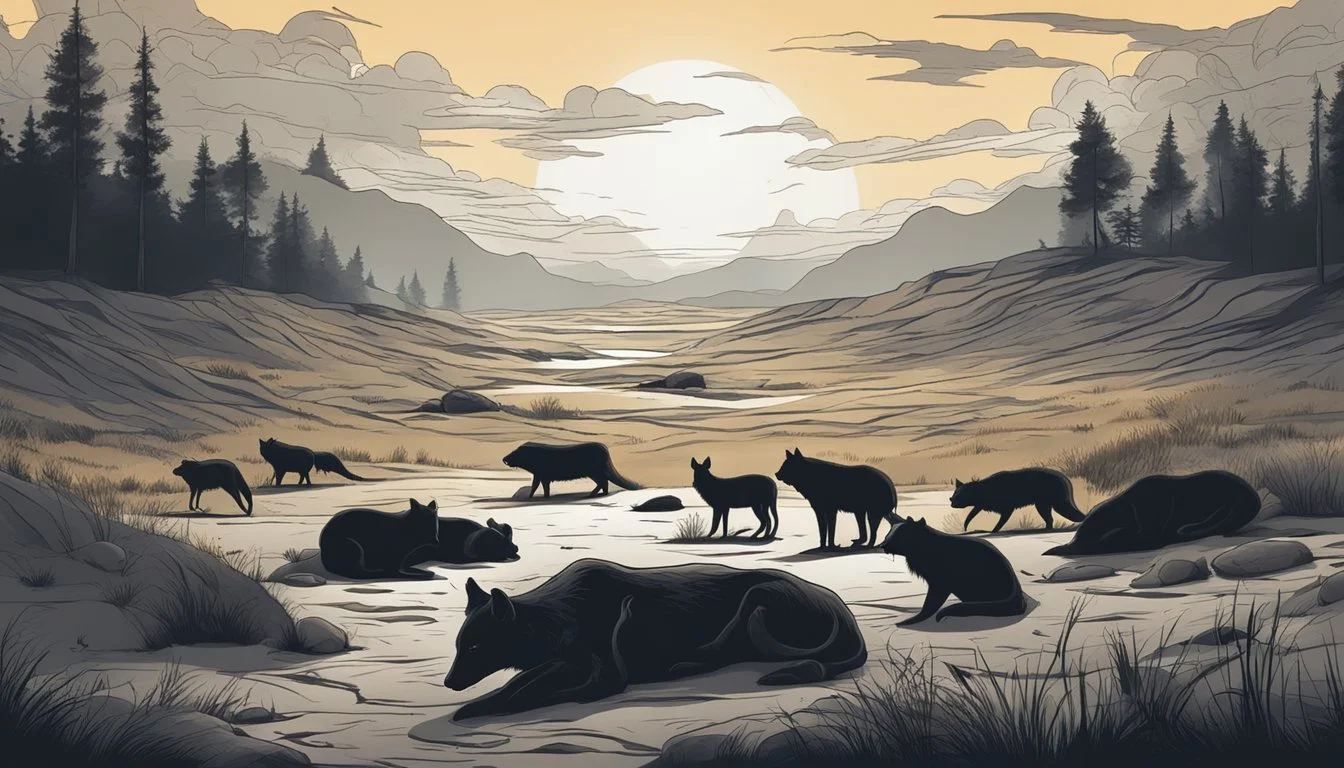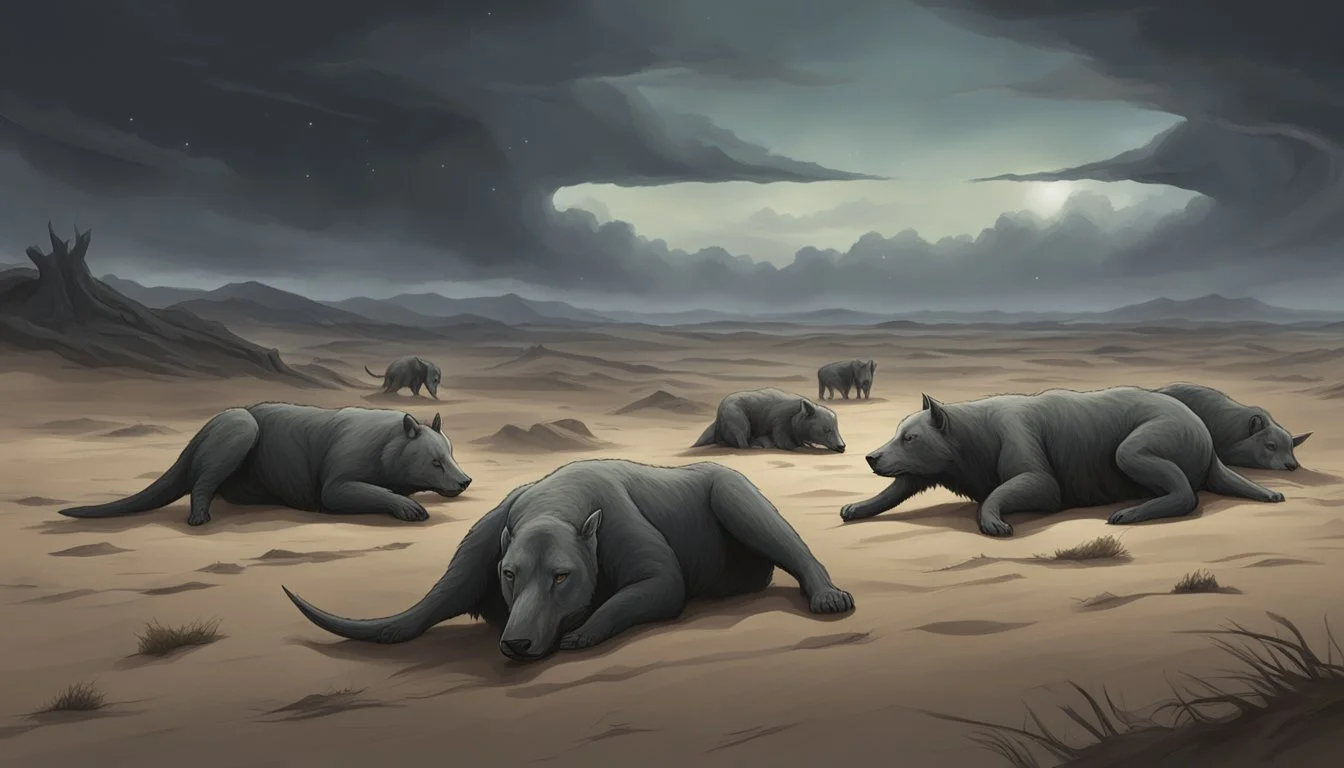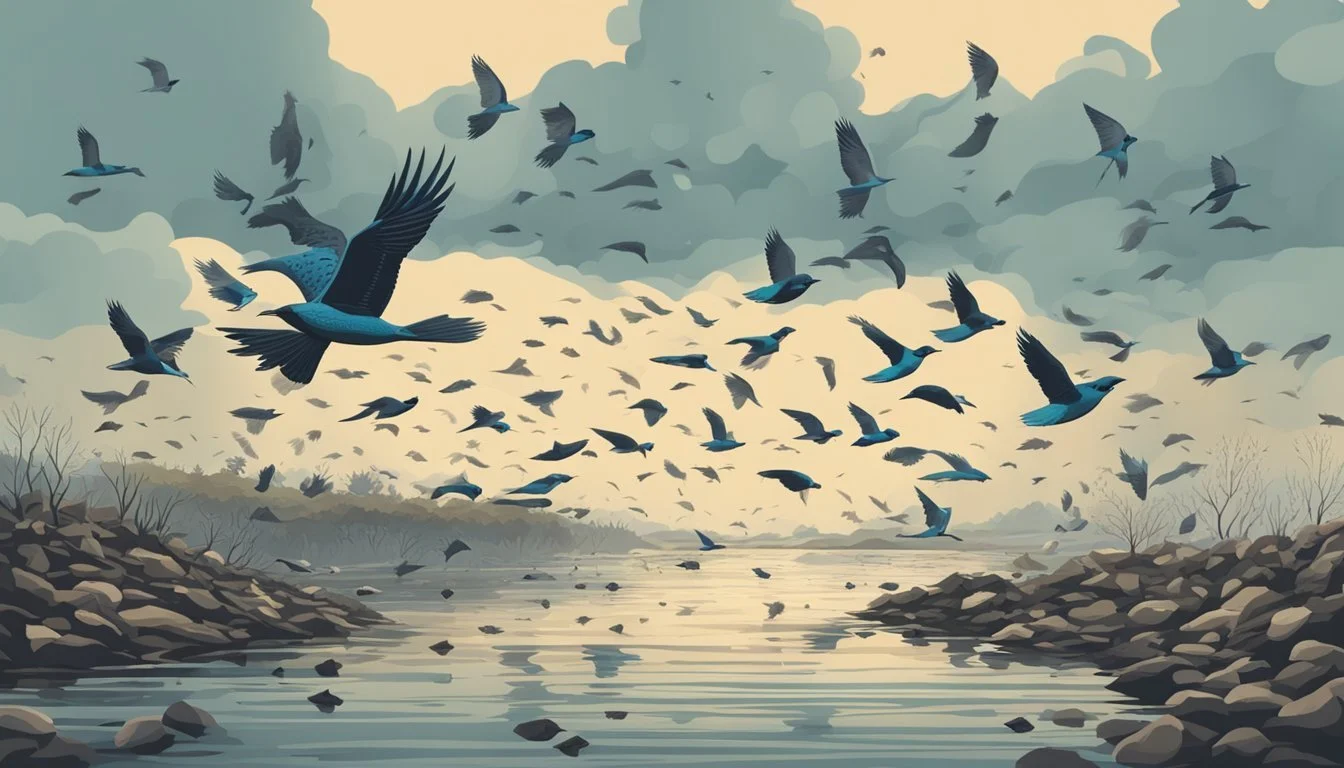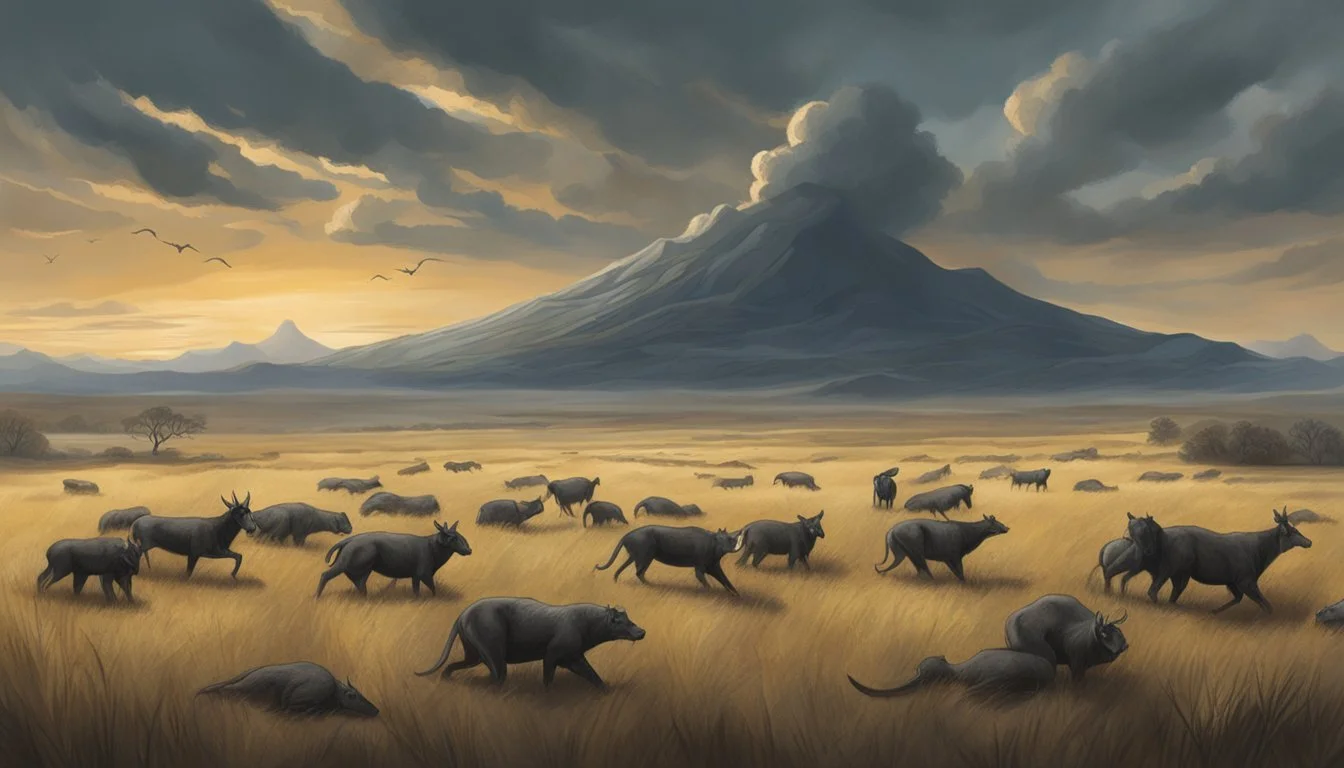6 Disturbing Documentaries on Unexplained Mass Animal Deaths
Nature's Mysteries Unveiled
Unexplained mass animal deaths have long captivated and disturbed humans. These mysterious events, where large numbers of animals suddenly perish without clear cause, challenge our understanding of the natural world and often spark intense speculation.
Documentaries exploring these phenomena shed light on potential explanations while highlighting the unsettling nature of such occurrences. By examining various cases of unexplained mass animal deaths, these films reveal the complex interplay between environmental factors, human activity, and the delicate balance of ecosystems. From fish washing up on shores to birds falling from the sky, these documentaries offer a window into some of nature's most perplexing and unsettling events.
1) The Cove
"The Cove" is a 2009 documentary that exposes the annual dolphin hunt in Taiji, Japan. Directed by Louie Psihoyos, the film follows a team of activists led by Ric O'Barry, a former dolphin trainer turned advocate.
The documentary reveals the secret slaughter of approximately 20,000 dolphins each year in a hidden cove. Using advanced technology and covert filming techniques, the team captures disturbing footage of the hunt.
The film highlights the brutal methods used to capture and kill the dolphins. It also explores the potential health risks associated with consuming dolphin meat due to high mercury levels.
"The Cove" garnered significant attention and accolades, including the Academy Award for Best Documentary Feature in 2010. It sparked international outrage and raised awareness about the ethical issues surrounding dolphin hunting.
The documentary's impact extended beyond its release, inspiring continued activism and efforts to end the practice in Taiji. It remains a powerful example of how investigative filmmaking can shed light on hidden animal welfare issues.
2) Blackfish
"Blackfish" is a groundbreaking documentary that exposed the dark side of keeping orca whales in captivity. Released in 2013, the film focuses on Tilikum, a male orca responsible for three human deaths at SeaWorld Orlando.
Director Gabriela Cowperthwaite skillfully weaves together interviews, archival footage, and expert testimony to paint a disturbing picture of the marine park industry. The documentary reveals the physical and psychological toll captivity takes on these intelligent creatures.
"Blackfish" had a profound impact on public perception of SeaWorld and similar attractions. In the year following its release, SeaWorld's attendance dropped by one million visitors. The company also experienced significant financial losses, with an 84% fall in income and a 33% drop in share price.
The film's influence extended beyond SeaWorld, sparking broader conversations about animal welfare in entertainment. It prompted numerous individuals to reconsider their stance on marine mammal captivity and led to increased scrutiny of animal-based attractions worldwide.
"Blackfish" stands as a powerful example of documentary filmmaking's potential to drive social change and challenge long-standing practices in animal entertainment industries.
3) The Elephant in the Living Room
"The Elephant in the Living Room" is a documentary that explores the controversial world of exotic pet ownership in the United States. Directed by Michael Webber, the film delves into the growing trend of keeping dangerous wild animals as household pets.
The documentary follows Tim Harrison, a public safety officer, as he responds to emergencies involving exotic animals. It also features Terry Brumfield, a man who keeps two African lions in his backyard.
Webber's film sheds light on the risks associated with keeping wild animals in captivity. It examines the motivations behind this practice and the potential consequences for both humans and animals.
The documentary raises important questions about animal welfare and public safety. It explores the legal and ethical implications of exotic pet ownership in America.
Through interviews and real-life footage, "The Elephant in the Living Room" provides a balanced look at this complex issue. It showcases the passion of exotic pet owners while highlighting the dangers and challenges they face.
4) Tyke Elephant Outlaw
"Tyke Elephant Outlaw" is a documentary released in 2015 that explores the tragic story of Tyke, a circus elephant. The film was directed by Susan Lambert and Stefan Moore.
Tyke's story gained international attention in 1994 when she rebelled during a circus performance in Honolulu, Hawaii. The incident resulted in the death of her trainer and Tyke's own demise in a hail of gunfire.
The documentary delves into the controversial world of animals in entertainment, particularly focusing on the treatment of elephants in circuses. It examines Tyke's life from her capture in Mozambique to her years in captivity.
Tyke's rampage was captured on film, providing a stark visual representation of the consequences of animal exploitation. The footage serves as a centerpiece for the documentary's narrative.
The film raises important questions about animal rights and the ethics of using wild animals for human entertainment. It presents interviews with witnesses, animal welfare advocates, and individuals involved in Tyke's life.
"Tyke Elephant Outlaw" sheds light on the ongoing debate surrounding animal welfare in the entertainment industry. It serves as a poignant reminder of the potential consequences of keeping wild animals in captivity for human amusement.
5) The Ghosts in Our Machine
"The Ghosts in Our Machine" is a 2013 Canadian documentary film directed by Liz Marshall. The film follows photojournalist and animal rights activist Jo-Anne McArthur as she documents the lives of animals in various industries.
McArthur's photography captures the hidden realities of animals used for food, fashion, entertainment, and research. Her images provide a window into the often unseen world of industrial animal exploitation.
The documentary takes viewers on a journey through undercover investigations and rescue missions around the globe. It showcases both the harsh conditions many animals face and the joyful moments of animals saved from these situations.
Unlike some animal rights documentaries that rely on shock value, "The Ghosts in Our Machine" takes a more gentle approach. It aims to educate viewers about animal welfare issues through compelling visuals and storytelling.
The film raises important questions about our relationship with animals in modern society. It challenges viewers to consider the moral implications of how animals are treated in various industries.
"The Ghosts in Our Machine" serves as a powerful plea for animal rights, using photography to illuminate the lives of individual animals affected by human activities.
6) The Cove: Dolphin Disappeared
"The Cove" is a 2009 documentary film directed by Louie Psihoyos that exposes the controversial dolphin hunting practices in Taiji, Japan. The film follows a team of activists led by Ric O'Barry, a former dolphin trainer, as they attempt to document the annual dolphin drive hunt.
The documentary reveals the brutal capture and slaughter of dolphins in a secluded cove near Taiji. Thousands of dolphins are herded into the cove each year, where some are selected for captivity in marine parks while others are killed for their meat.
Using advanced technology and covert filming techniques, the team captures shocking footage of the hunts. The film highlights the ethical concerns surrounding these practices and their potential impact on both dolphin populations and human health.
"The Cove" garnered significant attention upon its release, winning the Academy Award for Best Documentary Feature in 2010. It sparked international debate about dolphin hunting and the treatment of marine mammals in captivity.
The documentary's revelations led to increased scrutiny of Taiji's dolphin drives and raised awareness about the broader issues of cetacean conservation and welfare. Its impact continues to resonate in discussions about marine mammal protection and the ethics of animal captivity.
Causes of Mass Animal Deaths
Mass animal deaths can result from a complex interplay of factors. Environmental changes, human activities, and disease outbreaks are key contributors to these tragic events.
Environmental Factors
Extreme weather events often trigger mass animal deaths. Sudden temperature shifts can be lethal, especially for temperature-sensitive species. Heatwaves may cause fish kills in lakes and rivers by depleting oxygen levels.
Severe storms and hurricanes can disorient migratory birds, leading to collisions with buildings or exhaustion. Natural toxins, like harmful algal blooms, pose threats to marine life. These blooms release neurotoxins that affect fish, birds, and mammals.
Geomagnetic disturbances may disrupt animals' navigation abilities. This can cause birds to fly off course or whales to beach themselves. Seismic activity and underwater landslides can also impact marine ecosystems, leading to mass deaths.
Human Impact
Pollution is a significant cause of mass animal deaths. Oil spills devastate marine habitats, coating birds' feathers and poisoning fish. Chemical runoff from agriculture and industry contaminates water sources, harming aquatic life.
Habitat destruction forces animals into unfamiliar territories. This increases stress and vulnerability to predators or lack of food. Overfishing depletes fish populations and disrupts marine food chains.
Noise pollution from ships and sonar can disorient whales and dolphins. This may cause them to strand on beaches. Collisions with vehicles are a major threat to terrestrial animals, especially during migration periods.
Diseases and Pathogens
Infectious diseases can spread rapidly through animal populations. Avian influenza has caused mass deaths in wild and domestic bird populations. Canine distemper virus affects various carnivore species, including wolves and seals.
Fungal infections like white-nose syndrome have decimated bat populations. Parasites can also cause widespread mortality, as seen with sea star wasting disease. Climate change is altering disease patterns, allowing pathogens to spread to new areas.
Toxic algal blooms produce neurotoxins that accumulate in shellfish. When birds or marine mammals consume these shellfish, it can lead to mass poisonings. Botulism outbreaks in lakes and wetlands can kill large numbers of waterfowl.
Historical Cases of Unexplained Mass Animal Deaths
Mass animal deaths have puzzled scientists and the public for centuries. These events often involve hundreds or thousands of animals dying simultaneously without clear explanation. Careful study of past occurrences reveals intriguing patterns and challenges researchers.
Patterns and Recurring Events
In 1961, thousands of seabirds washed up dead along California's coast. Similar incidents occurred in the same area in 1980 and 1991. These cyclical events point to potential environmental factors.
Mass fish die-offs have been documented since ancient times. The Roman naturalist Pliny the Elder recorded incidents in the 1st century AD. More recent cases include 20 tons of fish found dead in a Bolivian lake in 2016.
Bird falls, where flocks drop from the sky, have sparked much speculation. In 1896, over 1,000 waterfowl plummeted to their deaths in Utah's Great Salt Lake. A 2011 incident in Arkansas saw 5,000 red-winged blackbirds fall dead on New Year's Eve.
Scientific Investigations
Researchers employ various methods to unravel these mysteries. Necropsies and toxicology tests can reveal internal injuries or poisoning. Environmental data analysis helps identify potential natural causes like extreme weather or low oxygen levels in water.
In some cases, human activity is implicated. The 1961 California seabird deaths were linked to a toxic algal bloom caused by agricultural runoff. Other incidents remain unexplained despite extensive study.
Advances in technology aid investigations. Satellite imagery tracks algal blooms and water temperatures. GPS tracking of animal movements provides crucial data on their behavior before mass mortality events occur.
Filmmaker Perspectives
Documenting unexplained mass animal deaths presents unique challenges for filmmakers. They must navigate complex ethical considerations while striving to capture sensitive subject matter in a responsible and impactful way.
Ethical Considerations in Documentary Filmmaking
Filmmakers covering mass animal deaths face difficult ethical choices. They must balance the need to inform the public with respect for the animals and ecosystems affected. Many struggle with whether to show graphic imagery or sanitize the reality of these events. Some choose to focus on scientific explanations and expert interviews rather than disturbing visuals. Others feel an obligation to present the full, uncensored truth to viewers. Filmmakers also grapple with how to avoid sensationalism while still conveying the scale and significance of these incidents.
Challenges in Capturing Sensitive Topics
Filming mass animal deaths poses logistical and emotional hurdles. Access to affected areas is often restricted, requiring persistence and creativity to obtain footage. The sights and smells can be overwhelming, testing filmmakers' resolve. Many report feeling traumatized after witnessing piles of carcasses or suffering animals. Technical challenges include safely operating equipment in potentially hazardous environments. Filmmakers must also navigate the emotions of grieving communities and wary officials. Building trust with scientists and local residents is crucial for gaining insights beyond surface-level observations.








